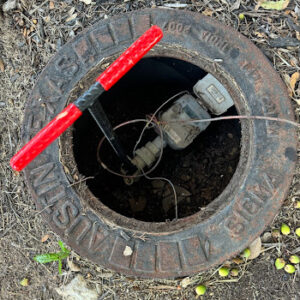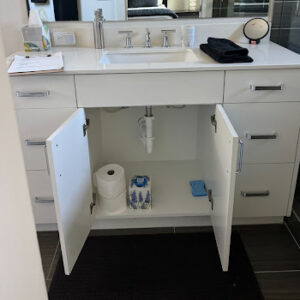How to Protect Your Home During a Freeze and Return Safely - UPDATED 2/2024

As the cold weather approaches, it’s essential to be prepared for freezing temperatures and the potential impact on your home. Whether you’re staying put during a freeze or temporarily leaving, taking the right precautions can save you from costly damage and ensure a smooth return. In this guide, we’ll walk you through different levels of protection and offer a plan for safely returning to your home after a winter storm.
Please note that while this guide provides valuable steps to protect your home during a freeze and safely return afterward, it may not cover all possible scenarios. Every home is unique, and the severity of winter storms can vary. The specific measures required may depend on various factors, including your location, the age and condition of your home, and the extent of the freeze. Use your discretion and consider consulting with home maintenance professionals if you have concerns about the best practices for your particular situation.
Key Message
Your home’s winter readiness is crucial, requiring your active participation, no matter how much preparation you undertake. You are the final line of defense in safeguarding your home.
After a winter storm, the next critical period to be mindful of is during the thaw. Any issues within your home, such as burst pipes, become most noticeable during this time and can inflict the most damage.
It may seem like there are many active measures that need to be taken, but this is because Texas homes are not constructed to endure harsh freezing temperatures.
Level 1: Occupying Your Home During a Freeze
If you’re staying in your home during a freeze and still have electricity and flowing water, here are some best practices:
- Perform Preventive Measures: Follow the preventive steps
outlined in our “15 Ways to Protect Your Home From a Freeze” blog. - Locate Whole House Water Shut-off: Find your home’s water shut-off valve and keep the water shut-off key handy for emergencies.

- Locate Exterior Sink(s) and/or Shower Shut-off(s): Cut water off to any exterior water fixtures and fully open those faucets to relieve pressure.

- Drip All Sinks & Open Sink Cabinets: Ensure that all sinks on the exterior walls have the cabinets open to allow warm air to surround the plumbing. Dripping a small amount of cold and hot water will help keep the pipes from freezing.
- RPZ/Backflow Preventers & Water Wells: In Austin, TX, these are the #1 areas of damage during a storm. If you have not implemented any form of active insulation (IE heat tape), you must shut off these units and drain them.
- Keep the house warm.
- Pier and Beam Foundation Homes: It is critical that the vents for pier and beam foundation are closed prior to temperatures reaching freezing. Ideally they are louvered to open or close by season, but you can also put covers on to seal those vents.
Important Note:
Differentiate between a homeowner shut-off or city shut-off. City shut-off valves are owned by the city, and technically, only city personnel can operate them. Furthermore, they require a special tool for shutdown. If you haven’t already installed one, consider adding a homeowner shut-off valve for easy access in case of an emergency.

15 Ways to Protect Your Home From a Freeze
To help you prepare for the cold, we’ve compiled a list of essential tasks to tackle before the freeze arrives.
HomePoint Freeze Audit: Included for Every HomePoint Subscriber
All HomePoint members receive freeze audits as part of their subscription.
Level 2: Occupying Your Home with Lost Electricity
If you lose electricity but still have flowing water, consider these additional steps:
- Perform All Level One Actions.
- Run Tub Faucets: Turn on the hot and cold water in all tubs with a small stream to keep water flowing through all plumbing in your home and prevent freezing.
Level 3: Leaving Your Home Unoccupied During a Freeze
For those leaving their homes unoccupied during a freeze, or if city water is unavailable, follow these steps:
- Perform all Level One and Level Two actions.
- Unplug appliances that have internal pumps, like recirculating pumps and under counter ice makers.
- Turn off the whole house water shut-off.
- Unplug and drain tankless water heaters. If you have tankless water heaters, open their service valves to drain them. Skip this step if you have a traditional tank water heater.
- Shut off and drain RPZ/Backflow Preventers & Water Wells.
- Fully open all faucets to release any remaining water pressure.
Important Note:
Exercise caution with appliances such as recirculating pumps or under-counter ice makers. If you experience a loss of water or need to turn off your water supply, be sure to power down any appliances that rely on water, such as recirculating pumps, pond autofill, or ice makers.
Returning Home After a Winter Storm
- Turn off all faucets, both exterior and interior.
- Open a tub and an exterior faucet, preferably the one furthest from your home's water shut-off.
- Slowly turn the water back on. Do this by opening the valve in small increments, waiting at least 5 seconds between each increment. This process should take 30 to 60 seconds in total.
- Close the previously opened valves, including the tub and exterior faucet.
- Open and close other faucets to clear the air out of the lines.
- Observe the city meter for at least a minute. If the meter is running, there is a high chance that you have a leak somewhere, and you need to turn off the water to the house.
- Power up appliances such as tankless water heaters, recirculating pumps, and ice makers. Congratulations, you've safely navigated through the freeze!
